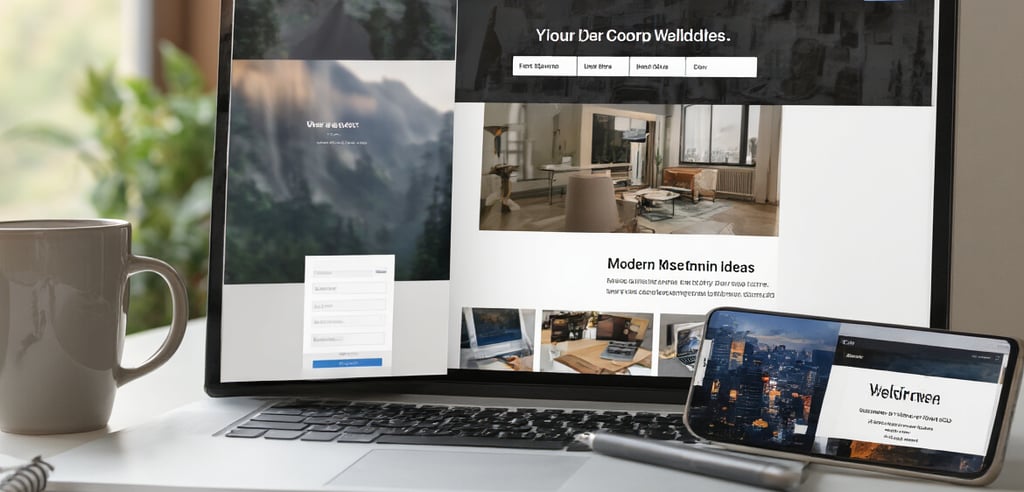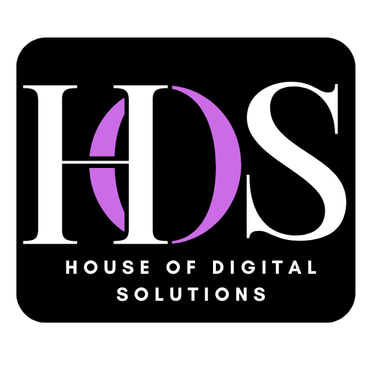Online Presence 101: From Zero to Digital Hero
New to the digital world? This guide is for small business owners and professionals who need to build their online presence from scratch. We'll walk you through understanding the digital landscape, setting up your first website, and mastering social media basics to connect with your audience. Skip the tech jargon—let's make getting online simple and effective for your brand.
ONLINE PRESENCE
8/11/202514 min read


Understanding the Digital Landscape
Why an Online Presence Matters in Today's World
Gone are the days when having a digital presence was optional. Now? It's as essential as having a phone number.
Think about it. When was the last time you looked for a business and didn't Google it first? Exactly.
Your online presence is your 24/7 ambassador. While you're sleeping, potential customers are checking out your website, scrolling through your social media, or reading reviews about you.
The numbers don't lie. About 97% of consumers search online for local businesses. If you're invisible online, you're basically handing your customers to competitors on a silver platter.
But it's not just about being found. It's about controlling your narrative. Without an active online presence, others define your brand for you. And trust me, you might not like their version.
Assessing Your Current Digital Footprint
Ready for a reality check? Google yourself or your business name. What shows up? Is it what you want people to see?
Your digital footprint includes:
Social media profiles
Website and blog content
Online reviews
Mentions on other websites
Images and videos
Most people are shocked when they see what's actually out there about them. Sometimes it's outdated info. Other times it's content they forgot existed.
Setting Clear Goals for Your Online Journey
Throwing yourself into the digital world without a plan is like driving without a destination. You'll just burn gas.
Start by asking:
Who am I trying to reach?
What do I want them to do?
How will I measure success?
Your goals might include:
Awareness - Get more people to know your brand - Website traffic, social media followers
Engagement - Build deeper connections - Comments, shares, time on site
Conversion - Turn interest into action - Sales, sign-ups, downloads
Pick 2-3 goals max. Trying to do everything at once is the fastest way to accomplish nothing.
Building Your Foundation


Securing Your Digital Identity
Ever had that moment when you tried to register for a service only to find your name's already taken? Frustrating, right?
Grab your name across platforms now, even if you're not ready to use them yet. It's like claiming your plot in the digital landscape before someone else does.
Start with:
Your full name (firstlastname.com)
A professional variant (johnsmithwriter.com)
A creative pseudonym if needed
Pro tip: Check availability using namecheckr.com or knowem.com before you get your heart set on something.
Think about how you'll manage these accounts. A password manager isn't just convenient—it's practically mandatory these days. LastPass, 1Password, or Bitwarden will save your digital life one day, trust me.
Choosing the Right Platforms for Your Needs
The platform game isn't about being everywhere—it's about being where it matters.
Platform Type - Best For
LinkedIn Professional networking, B2B
Instagram Visual portfolios, lifestyle brands
Twitter News, quick engagement, thought leadership
TikTok Creative content, younger audiences
YouTube In-depth tutorials, vlogs
Here's the truth: mastering one platform trumps half-hearted presence on five. Where does your target audience actually hang out? Go there.
Creating a Cohesive Personal Brand
Your digital brand isn't just a logo or color scheme. It's the story you tell when nobody's looking.
The magic happens when someone can recognize your content without seeing your name. That consistency builds trust faster than anything else.
Ask yourself:
What three words describe my professional personality?
What visual elements reflect these traits?
What's my unique voice? (Funny? Educational? No-nonsense?)
The people who win online aren't necessarily the most qualified—they're the most consistent and recognizable.
Essential Tools for Digital Beginners
You don't need fancy equipment to start building online. You need these basics:
Canva for creating decent-looking graphics without design skills
Google Workspace or Microsoft 365 for professional email and document storage
A simple website builder (Squarespace, Wix, or WordPress)
Hootsuite or Buffer for scheduling social posts
Grammarly to catch those embarrassing typos
Don't blow your budget on premium subscriptions right away. The free versions of most tools work perfectly fine until you outgrow them.
Remember when smartphones were considered optional? That's how these tools will seem in hindsight—absolute necessities for anyone serious about their digital presence.
Creating Compelling Content


Finding Your Authentic Voice
Ever noticed how some content creators just seem... real? That's not by accident.
Your authentic voice is what makes readers stop scrolling. It's what turns casual browsers into loyal followers. Finding it isn't about mimicking successful bloggers—it's about sounding like you on your best day.
Start by writing how you talk. Record yourself explaining your topic to a friend, then transcribe it. See those phrases and expressions? That's your natural voice.
Don't be afraid to have opinions. The internet is crowded with fence-sitters. Taking a clear stance (even if some disagree) will attract your people.
Share personal stories. Nothing connects like "I've been there too" moments.
Content Types That Drive Engagement
Not all content performs equally. These formats consistently drive results:
How-to guides: People love solutions to specific problems
Lists: Scannable and satisfying (you're reading one now!)
Case studies: Real results speak volumes
Behind-the-scenes: Humans crave authenticity
User-generated content: Turning customers into creators builds community
The secret? Mix it up. Your audience needs variety to stay interested.
Basic Design Principles Anyone Can Master
Good design isn't magic—it's method.
White space is your friend. Don't cram everything together. Let your content breathe. Choose 2-3 colors and stick with them. Color consistency builds brand recognition. Typography matters. Pick one headline font and one body font. That's it. Alignment creates order. Line things up—it instantly looks professional. Images should enhance, not distract. Quality beats quantity every time.
Consistency vs. Quality: Finding the Balance
The eternal content creator's dilemma: post often or post perfectly? Truth bomb: consistency builds audiences, but quality keeps them. Start with a sustainable schedule. Better to post great content weekly than mediocre content daily that burns you out by month two. Batch similar tasks. Create three social posts at once instead of switching gears constantly. Set non-negotiable quality standards—aspects of your work you refuse to compromise on, even when rushed.
Content Planning for Long-term Success
Flying by the seat of your pants doesn't scale.
Create a content calendar—even a simple spreadsheet works. Map topics to business goals and seasonal trends.
Build content pillars—3-5 core themes that define your expertise. Every piece should connect to at least one pillar.
Plan content in series, not just one-offs. Connected content keeps people coming back.
Listen to your analytics. Double down on what works, gracefully abandon what doesn't.
The best content strategy evolves. Review and adjust quarterly based on results and audience feedback
Establishing Your Website


Domain Names and Hosting Simplified
Finding the perfect domain name is like choosing your digital street address. It's what people type to find you, so make it count.
Short, memorable names win every time. If "mybusiness.com" is taken (and let's be real, it probably is), try adding your location or a descriptor: "mybusinesschicago.com" or "bestmybusiness.com".
As for hosting? Think of it as renting digital land for your website. Here's what matters:
Shared hosting is best suited for beginners or small websites, typically costing between $3 and $10 per month. For growing businesses that need more resources and control, VPS hosting is a better option, with prices usually ranging from $20 to $50 per month. High-traffic websites that require maximum performance and dedicated resources should consider dedicated hosting, which generally costs between $80 and $500 per month.
Don't go crazy with fancy hosting when you're starting out. A decent shared hosting plan from Bluehost, SiteGround, or HostGator will do just fine.
B. Website Builders vs. Custom Development
The eternal debate! Here's the straight talk:
Website builders (Wix, Squarespace, WordPress) are like using pre-made furniture. Quick to set up, no coding needed, and pretty darn good for most people.
Custom development is crafting furniture from scratch. It takes longer and costs more, but you get exactly what you want.
Most small businesses and personal brands do perfectly well with website builders. They've come a long way—modern templates look professional and offer plenty of customization.
Go custom only when you need specific functionality that builders can't provide.
C. Must-have Elements for Any Effective Site
Skip these at your peril:
Clear navigation - People shouldn't need a treasure map to find your contact page
About section - Tell your story (briefly!)
Contact information - Make it ridiculously easy to reach you
Call-to-action buttons - What do you want visitors to DO?
Social proof - Testimonials, reviews, client logos
Fast loading speed - Nobody waits more than 3 seconds these days
Your homepage should answer three questions in seconds: What do you offer? How does it help me? What should I do next?
D. Mobile Optimization Essentials
Over 50% of web traffic is mobile now. Ignore this at your own risk.
Mobile optimization isn't optional anymore—it's survival. Google even ranks mobile-friendly sites higher.
The basics:
Text must be readable without zooming
Buttons need to be thumb-friendly (bigger than you think)
Forms should be simple (nobody's typing essays on phones)
Images must scale properly
Test on actual devices, not just simulators
Pro tip: Design for mobile FIRST, then expand to desktop. Way easier than trying to shrink a desktop site later.
Mastering Social Media


Platform Selection Strategy
Social media can make or break your digital presence. But here's the thing – you don't need to be everywhere.
Trying to maintain profiles on eight different platforms is a recipe for burnout. Instead, ask yourself: Where does my audience actually hang out?
A B2B consultant might crush it on LinkedIn but struggle on TikTok. A wedding photographer might thrive on Instagram and Pinterest but get crickets on Twitter.
Pick 2-3 platforms where your people genuinely spend time. Quality trumps quantity every single day of the week.
Instagram – Best for visual products and lifestyle brands; requires high time investment with regular stories, reels, and posts.
LinkedIn – Best for B2B and professional services; medium time investment with 1–2 posts daily.
TikTok – Best for youth-focused brands and entertainment; very high time investment due to the need for constant content creation.
Twitter (X) – Best for news, quick updates, and tech; high time investment with multiple posts daily.
Building a Following from Scratch
Nobody starts with 10,000 followers. Everyone begins at zero.
The secret? Consistency beats occasional brilliance. Post regularly – even when it feels like shouting into the void. Your first 100 followers will be the hardest to get.
Start by inviting friends and existing contacts. Then move to engaging with similar accounts in your niche. Comment thoughtfully on their content. Not "nice post!" but actual value-adding responses.
User-generated content is gold. Ask questions. Run simple polls. Share customer stories. People love seeing themselves featured.
Remember: followers who actually care about your content are worth 100x more than random numbers. A small, engaged audience beats a large, disinterested one every time.
Engagement Tactics That Actually Work
Social media algorithms reward engagement, not just posting. The platforms want conversations, not broadcasts.
Respond to every comment – especially in your early days. Ask follow-up questions. Make people feel heard.
Use the 80/20 rule: 80% value-giving content, 20% promotional. Nobody follows accounts that only talk about themselves.
Stories and time-limited content create FOMO (fear of missing out). Use them to share behind-the-scenes glimpses that make followers feel like insiders.
Want higher engagement? Post when your audience is actually online. Most platforms have analytics showing peak activity times.
And please, for the love of everything, stop using generic stock photos. Real, authentic imagery outperforms polished corporate visuals by miles.
Avoiding Common Social Media Pitfalls
Social media mistakes can haunt you for years. Avoid these common traps:
Inconsistent posting schedules confuse algorithms and followers alike. Better to post twice weekly reliably than daily for a week then disappear.
Buying followers is digital suicide. Those fake accounts won't engage, making your engagement rate plummet and algorithms punish you.
Ignoring negative comments makes everything worse. Address concerns publicly and professionally.
Jumping on every trend looks desperate. Only participate if it genuinely fits your brand voice.
The biggest mistake? Making it all about you. Social media should be social. Ask questions. Showcase customers. Share industry news. Build community, not just a megaphone for your business.
SEO Fundamentals


A. Keywords Research Without the Complexity
Finding keywords doesn't have to be rocket science. Seriously.
Most beginners freak out about keyword research, but here's the deal: start with what your customers are actually asking.
Write down 10-15 questions your potential customers might type into Google. Those are your seed keywords right there.
Want to level up? Try these free tools:
Google's autocomplete (just start typing in the search bar)
"People also ask" sections in search results
Answer the Public website
Don't obsess over search volume at first. A keyword with 100 monthly searches but high purchase intent beats a keyword with 10,000 searches from people who'll never buy.
B. On-page Optimization Techniques
Got your keywords? Great. Now sprinkle them naturally throughout your content—don't stuff them in like you're making keyword sausage.
Your checklist:
Put your main keyword in your page title (preferably near the beginning)
Include it in at least one H2 heading
Drop it in the first 100 words
Add it to your meta description
Use it in image alt text when relevant
Remember those little preview snippets in Google results? That's your meta description working hard for clicks. Make it compelling with a benefit or curiosity hook.
Also, break up your content with subheadings. Nobody wants to stare at a wall of text. Your readers' eyes need rest stops.
C. Building Backlinks for Beginners
Backlinks are like votes of confidence from other websites. And yes, you need them.
The easiest place to start? Look at where your competitors are getting links from. Tools like Ubersuggest (free version) can show you this.
Simple backlink strategies that actually work:
Create a resource page others in your industry would reference
Write testimonials for products you use (they'll often link back)
Get listed in relevant local directories
Guest post on related blogs
Create shareable infographics or unique data
Quality trumps quantity. One link from an authoritative site in your niche beats 20 links from random blogs.
D. Local SEO Tips for Maximum Visibility
Running a local business? Google My Business is your new best friend.
Claim and optimize your profile with:
Accurate business hours
Recent photos (update monthly if possible)
Your primary category AND secondary categories
A keyword-rich business description
Regular posts (like mini-blogs)
Ask happy customers to leave Google reviews. And—this is crucial—respond to every single one, good or bad.
Make sure your NAP (Name, Address, Phone) is consistent across all online platforms. Different addresses or phone numbers on different sites confuse Google and hurt your rankings.
E. Tracking Your SEO Progress
You can't improve what you don't measure. But don't drown yourself in data either.
Start with these key metrics:
Organic traffic (Google Analytics)
Keyword rankings (Google Search Console)
Click-through rate on your main pages
Bounce rate (are people sticking around?)
Conversion rate from organic traffic
Set up a simple monthly check-in with yourself. Has organic traffic increased? Are you ranking for more keywords? Are those rankings turning into actual business?
Remember that SEO takes time—often 3-6 months to see significant movement. But small wins along the way show you're on the right track.
Measuring Your Success


A. Key Metrics Worth Monitoring
Numbers don't lie, folks. If you're serious about growing online, you need to track the right stuff. Here's what actually matters:
Traffic: How many eyeballs are landing on your site
Bounce Rate: Are people sticking around or hitting the back button?
Conversion Rate: The percentage of visitors who take your desired action
Engagement: Comments, shares, time spent on page
Customer Acquisition Cost: What you're paying to get each new customer
Don't get lost in vanity metrics like follower counts. A million followers means nothing if they never buy what you're selling.
B. Free Analytics Tools to Start With
You don't need to drop cash to get solid insights. These free tools pack a punch:
Google Analytics: The gold standard for website data
Google Search Console: See how you're performing in search results
Facebook/Instagram Insights: Track social engagement if you're on these platforms
Hotjar (free tier): Watch how real visitors use your site
Canva Analytics: If you're creating visual content
These tools reveal the story behind your numbers—who's visiting, what they're doing, and where they're bouncing.
C. Interpreting Data to Improve Performance
Data is useless if you don't act on it. When you spot a page with high traffic but low conversions, that's a goldmine waiting to be optimized.
High bounce rates? Your content probably isn't delivering what was promised. Low engagement? Your call-to-action might be weak or confusing.
The magic happens when you connect different metrics. For example, if mobile visitors convert at half the rate of desktop users, your mobile experience needs work.
Don't just collect data—use it to make one improvement each week.
D. Setting Realistic Benchmarks
Comparing yourself to Amazon on day one is a recipe for disappointment. Instead:
Start with industry averages as a baseline
Track your own week-over-week improvements
Set goals that stretch you but don't break you
Good benchmarks for beginners:
5% monthly traffic growth
2% conversion rate
2-3 minute average session duration
Remember, overnight success usually takes about two years. The businesses that win are the ones that keep showing up, measuring what matters, and making consistent improvements based on real data.
Advancing Your Digital Presence


Automation Strategies for Time-Saving
Building a digital presence can eat up your whole day if you let it. But here's the thing - you don't have to do everything manually.
Set up social media scheduling tools like Buffer or Hootsuite to post content across platforms automatically. Batching your content creation (writing 10 posts in one sitting) then scheduling them throughout the week? Game changer.
Email marketing platforms can segment your audience and trigger specific messages based on behavior. Someone downloads your free guide? They automatically get your follow-up sequence without you lifting a finger.
Chatbots on your website handle basic questions 24/7, freeing you up for the complex stuff that actually needs your brain. And those repetitive admin tasks? Zapier connects your apps to create workflows that happen behind the scenes.
The magic equation is simple: Automation = More impact with less effort.
Collaboration Opportunities for Growth
Your digital presence explodes when you stop trying to do it all alone.
Guest blogging puts you in front of established audiences. That podcast interview? It leverages someone else's platform to showcase your expertise. Joint webinars split the workload while doubling the promotion power.
Cross-promotion with complementary businesses (not competitors) works wonders. The yoga instructor and the meditation app. The resume writer and the interview coach. These partnerships make total sense to audiences.
Micro-influencers in your niche often deliver better engagement than mega-celebrities. Their audiences trust them, and that trust transfers to you when they share your stuff.
The digital world rewards collaboration. Nobody builds a significant online presence in isolation.
Paid Promotion: When and How to Invest
Organic reach isn't what it used to be. Sometimes you need to put money behind your message.
Start small with paid promotion. Test $50 on Facebook ads before dropping $500. The platforms want your money, but they don't care if it works for you.
Retargeting campaigns (showing ads to people who've already visited your site) typically deliver 3-5x better ROI than cold audience targeting. These people already know you - they just need a nudge.
Timing matters enormously with paid promotion. Launching a winter coat campaign in July? Probably not smart. Running holiday specials in November? Now we're talking.
Different platforms serve different purposes:
LinkedIn ads → B2B services, high-ticket items
Instagram → Visual products, lifestyle brands
Google → People actively searching for solutions
Don't spray and pray with your ad budget. Pick the platform where your people actually hang out.
Staying Current with Digital Trends
The digital landscape shifts faster than most of us change our passwords.
RSS feeds from tech blogs deliver industry news straight to your inbox. Digital marketing podcasts turn your commute into learning time. Those 20 minutes in traffic? They're now keeping you ahead of the curve.
Follow thought leaders on Twitter (or X, whatever we're calling it now) for real-time insights. The best ones share what's working before it becomes mainstream knowledge.
Industry reports from major platforms give you data-backed trend analysis. When Facebook publishes their quarterly insights, smart marketers pay attention.
But don't chase every shiny new platform. TikTok might be hot, but if your audience is senior executives, your time might be better spent elsewhere.
The goal isn't to be everywhere or try everything. It's to spot the relevant shifts that matter for your specific digital presence.
Navigating the digital landscape may seem overwhelming at first, but following the step-by-step approach outlined in this guide can transform you from a digital novice to an online authority. From building your foundation and creating compelling content to establishing your website and mastering social media platforms, each element works together to create a cohesive online presence that resonates with your audience.
Remember that digital success doesn't happen overnight. Apply SEO fundamentals consistently, measure your results regularly, and continuously look for ways to advance your digital footprint. Whether you're a small business owner, creative professional, or personal brand, your online journey is an ongoing evolution. Start implementing these strategies today, and watch your digital presence grow from zero to hero.
Custom Solutions
Tailored strategies for your digital & business success journey.
Policies
Future
email: info@hods.io
Call : +92 318 249 5037
© 2025. All rights reserved by House of Digital Solutions
+44 759 968 2726
IMPACT
